What country is Madeira in? Where is the Island of Madeira? What is the best time to travel to Madeira? What is the currency in Madeira? How to find accommodation for rent in Madeira?
If you want to know the answers to these questions and other interesting facts about Madeira, read our guide that can help you enhance your knowledge and experience as a tourist, digital nomad, or expat.
Geography, language, and population in Madeira
Is Madeira in Portugal?
The answer is yes. Madeira is indeed part of Portugal. It's an autonomous region of Portugal located in the Atlantic Ocean, southwest of Portugal itself.
Here’s a map of Madeira:
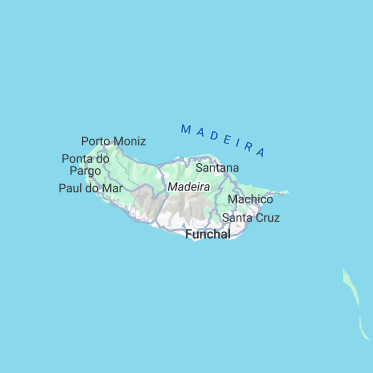
Is Madeira its own country?
No, Madeira is not its own country. It is an autonomous region of Portugal.
Where is Madeira island located?
Madeira is an autonomous region of Portugal located in the Atlantic Ocean, southwest of Portugal's mainland. Specifically, it's situated approximately 310 miles (500 kilometers) west of the Moroccan coast and about 620 miles (1,000 kilometers) from the European continent.
How many people live in Madeira?
The Madeira population was around 250,769 in 2021.
What is the capital of Madeira?
The Funchal city is the capital of Madeira island Portugal.
Find perfect accommodation in Madeira
What is the population of Funchal in Madeira?
Based on the 2021 census, the Funchal population is 105,782.
What is the Madeira language?
The official language of Madeira is Portuguese, as it is a region of Portugal.
Where is Madeira in Europe?
Madeira is located in the Atlantic Ocean, southwest of Portugal, and is considered part of Europe as an autonomous region of Portugal.
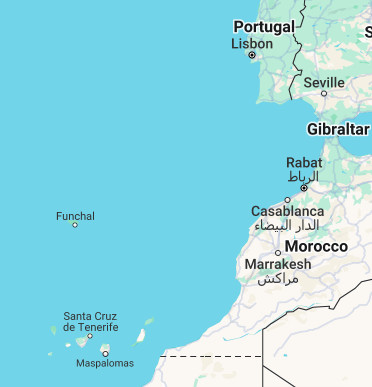
Where is Madeira located on the world map?
Madeira is located in the Atlantic Ocean, southwest of Portugal's mainland. Its coordinates are approximately 32.7607° N latitude and 16.9595° W longitude. If you look at the world map below, you can find Madeira as a small cluster of islands southwest of Portugal and northwest of the African continent.
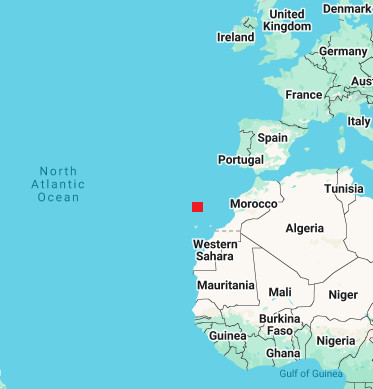
How far is Madeira from Portugal?
Madeira is approximately 620 miles (1,000 kilometers) southwest of Portugal's mainland.
Where is the highest point in Madeira?
The Madeira highest peak is Pico Ruivo.
How high is the Madeira highest point?
Pico Ruivo, the highest mountain in Madeira, stands tall at 1,862 meters (6,106 feet) above sea level.
How large is the Madeira area?
The Madeira archipelago includes several islands. The biggest one is the Island of Madeira, covering about 741 square kilometers (286 square miles). It stretches around 57 kilometers (35 miles) from Ponta de São Lourenço in the east to Ponta do Pargo in the west. At its widest, it's approximately 22 kilometers (14 miles) from Ponta da Cruz to Ponta de São Jorge.
Madeira Island has a coastline extending for about 150 kilometers (90 miles).
What is the Madeira wildlife like?
Madeira's wildlife is characterized by a variety of species, including birds, insects, and marine life. The island is known for its diverse ecosystems, from lush forests to coastal areas, providing habitats for a range of flora and fauna.
What animals live in Madeira?
Madeira is home to various animals, including birds such as the Madeira laurel pigeon and the Zino's petrel, as well as reptiles like the Madeiran wall lizard.
Additionally, marine life such as dolphins and whales can be spotted in the waters surrounding the island.
Are there dangerous animals in Madeira?
While Madeira is generally safe in terms of wildlife, there are no significant dangerous animals native to the island. Visitors are unlikely to encounter any dangerous or venomous creatures.
Is Madeira volcanic?
Yes, Madeira is of volcanic origin. The island was formed through volcanic activity millions of years ago, and evidence of its volcanic past can be seen in its rugged landscapes, steep cliffs, and volcanic rock formations.
However, the island is not currently volcanically active.
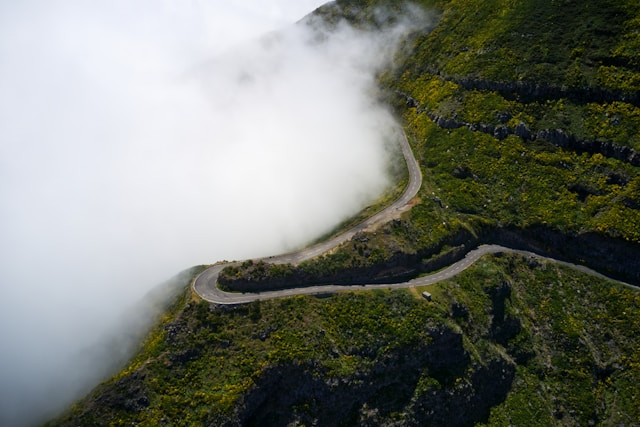
What is the distance from Porto to Madeira?
The distance from Porto to Madeira, measured in a straight line, is approximately 1,070 kilometers (about 665 miles). However, the actual travel distance may vary depending on the mode of transportation in Portugal used (e.g., air or sea routes) and specific departure and arrival points.
Interested in learning more about other destinations in Portugal?
On our website you will find travel guides and information about destinations in Portugal beyond Madeira, including:
Madeira tourism
Do you need a visa to go to Madeira?
Whether you need a visa to go to Madeira depends on your nationality and the purpose of your visit. Madeira is part of Portugal, so entry requirements to Madeira are the same as for visa in Portugal.
Citizens of many countries, such as those in the European Union, the United States, Canada, Australia, and many others, do not need a visa for short visits (typically up to 90 days) for tourism or business purposes.
However, it's essential to check the specific visa requirements based on your nationality and the purpose of your visit before traveling to Madeira. You can find this information on the official website of the Portuguese embassy or consulate in your country.
Is Madeira Portugal worth visiting?
Is Madeira a good place to visit, you ask? Absolutely. Madeira is worth exploring for its breathtaking natural beauty, mild climate, and rich cultural heritage.
Whether you're drawn to its stunning landscapes, including lush forests and rugged coastline, or interested in its unique local culture and delicious cuisine, Madeira offers a memorable experience for travelers. From hiking along scenic trails to sampling local wines and indulging in fresh seafood, Madeira has something to offer every visitor.
What are the main tourist attractions in Madeira?
Some of the top places to see in Madeira include:
- Funchal Old Town (Zona Velha)
- Monte Palace Tropical Garden
- São Vicente Caves and Volcanism Center
- Cabo Girão Skywalk
- Levada Walks (e.g., Levada do Caldeirão Verde, Levada das 25 Fontes)
- Madeira Botanical Garden (Jardim Botânico da Madeira)
- Pico do Arieiro
- Madeira Theme Park (Parque Temático da Madeira)
- Porto Moniz Natural Swimming Pools
- Madeira Wine Lodges (e.g., Blandy's Wine Lodge, Henriques & Henriques)
When is the best time to go to Madeira Portugal?
The best time to visit Madeira Portugal is typically from April to October, with April and May being particularly recommended for the Flower Festival and slightly fewer crowds.
What are the best months to visit Madeira?
The best months to visit Madeira are typically from April to October. During this time, the weather is pleasantly warm, with temperatures ranging from the mid-60s to mid-70s Fahrenheit (around 18-24 degrees Celsius).
These months offer plenty of sunshine and minimal rainfall, making it ideal for outdoor activities such as hiking, sightseeing, and enjoying the island's beaches. And there are fewer crowds during these months and you can avoid higher prices associated with the peak tourist season.
However, if you're specifically interested in experiencing Madeira's famous flower festival or other events, you may want to plan your visit during specific festival dates, which usually occur in April or May.
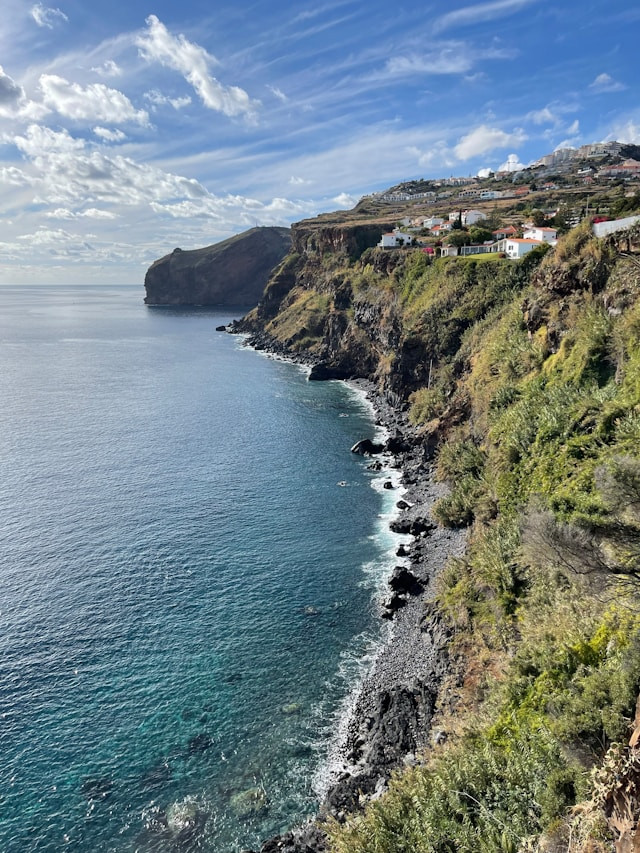
What is the best month to visit Madeira, Portugal?
The best month to visit Madeira, Portugal, is typically April to October, with April and May being particularly recommended for the Flower Festival and slightly fewer crowds.
When is the cheapest time to visit Madeira?
The cheapest time to visit Madeira is generally during the off-peak months of November to March, excluding the Christmas and New Year holiday period.
During these months, you can often find lower prices on accommodations, flights, and activities compared to the peak tourist season from April to October.
Where is the best part of Madeira?
Determining the "best" part of Madeira can depend on individual preferences and interests. However, many visitors consider Funchal, the capital city, to be a highlight due to its picturesque harbor, historic sites, botanical gardens, and vibrant atmosphere.
Additionally, the coastal areas, such as São Vicente and Porto Moniz, offer stunning landscapes with dramatic cliffs, natural pools, and picturesque villages. Outdoor enthusiasts often enjoy exploring the Levada walks, which are irrigation channels converted into hiking trails, providing access to the island's lush landscapes and scenic vistas.
What are the main cities in Madeira?
These are some of the main cities, towns, and municipalities in Madeira:
- Funchal: The capital and largest city of Madeira, located on the southern coast. It has a picturesque harbor, historic sites, and lively atmosphere.
- Câmara de Lobos: A charming fishing village west of Funchal, known for its scenic views and traditional Madeiran culture.
- Machico: Situated on the eastern coast, Machico is famous for its sandy beach, historic sites, and scenic landscapes.
- Santa Cruz: This coastal town near Madeira Airport offers a pleasant promenade, beaches, and waterfront dining options.
- Ponta do Sol: Located on the southwestern coast, Ponta do Sol enjoys a sunny climate, picturesque setting, and historic appeal.
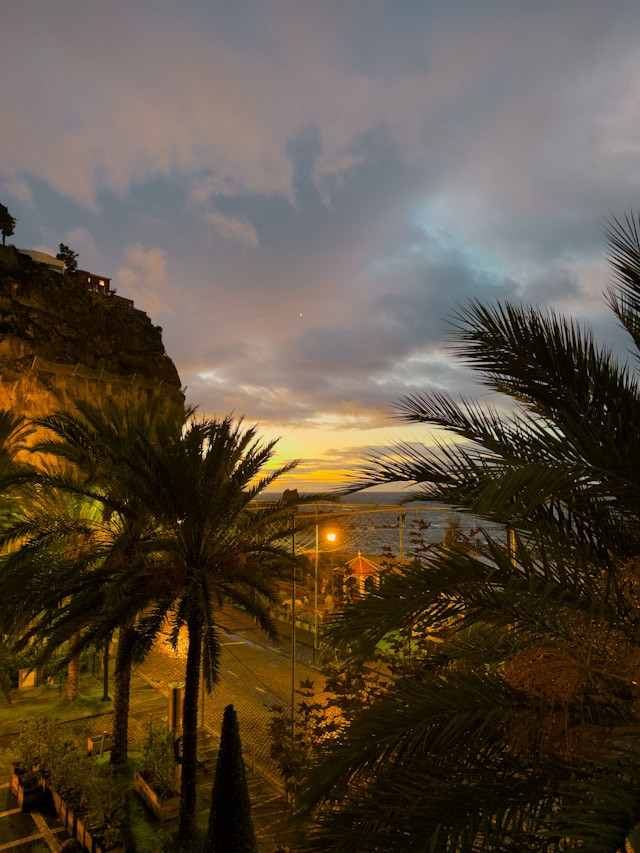
How safe is Madeira in general?
Madeira is generally considered a safe destination for travelers. The crime rate in Madeira Portugal is very low compared to many other tourist destinations, and violent crime is rare.
However, like any place, it's essential to exercise common sense and take basic precautions to ensure your safety, such as being aware of your surroundings, avoiding poorly lit or deserted areas at night, and safeguarding your belongings.
Is it safe to travel to Madeira now?
As of May 2024, Madeira is considered a safe destination for travelers. However, travel safety can be influenced by various factors such as natural disasters, political unrest, or public health concerns.
It's always a good idea to check the latest travel advisories and guidelines from official sources such as government travel websites or the World Health Organization before planning your trip.
How can I travel to Funchal in Portugal?
Wondering how to visit Madeira? You can travel to Funchal, Portugal by air or sea. Funchal has an international airport, Madeira Airport (FNC), which receives flights from various European cities as well as some international destinations. Alternatively, you can also travel to Funchal by sea, as it is a popular port of call for cruise ships.
What are the best places to visit in Funchal Madeira, Portugal?
Some of the best places to visit in Funchal include:
- Monte Palace Tropical Garden: A stunning botanical garden featuring exotic plants, lakes, and panoramic views of Funchal.
- Funchal Old Town (Zona Velha): Explore the unique narrow streets, historic buildings, and colorful markets of the old town.
- Funchal Marina: Enjoy a leisurely stroll along the waterfront, lined with cafes, restaurants, and shops, or take a boat tour to explore the coastline.
- Madeira Botanical Garden: Discover a diverse collection of plants from around the world in this beautiful botanical garden.
- São Tiago Fortress: Visit this historic fortress overlooking the sea, which now houses an art gallery and cultural center.
- Cable Car to Monte: Take a scenic cable car ride from Funchal to Monte, offering breathtaking views of the city and coastline below.
- Mercado dos Lavradores: Experience the lively atmosphere of Funchal's farmers' market, where you can find fresh produce, flowers, and local crafts.
- Monte Church (Igreja do Monte): Visit this church known for its ornate interior and impressive views of Funchal.
- Madeira Wine Lodges: Take a tour of one of the famous Madeira wine lodges in Funchal to learn about the production process and sample some of the island's renowned fortified wine.
- Jardim Municipal: Relax in this tranquil municipal garden, featuring lush greenery, colorful flowers, and a variety of exotic plants.
Does Madeira have sandy beaches?
Yes, Madeira does have some sandy beaches, although they are not as common as in other beach destinations. Most of the beaches in Madeira are rocky or pebbly, but there are a few sandy beaches that visitors can enjoy.
Some of the popular sandy beaches in Madeira include:
- Calheta Beach
- Machico Beach
- Praia Formosa in Funchal
To make the most of your beach experience, note that the best time of year to visit Madeira for this purpose is during the summer months, particularly from June to September.
How long in Madeira would be enough?
It’s not easy to say how much time in Madeira would be enough for a tourist as it depends on individual preferences, interests, and the purpose of your visit. For a basic exploration of the island's main attractions and natural beauty, a stay of around 4 to 7 days could be sufficient.
This duration allows you to visit Funchal, explore the island's scenic landscapes, take leisurely walks or hikes, and enjoy some outdoor activities.
However, if you want to delve deeper into Madeira's culture, history, and outdoor adventures, you might consider staying in Madeira for 10 days to two weeks or even longer. This would give you more time to explore the island's unique towns and villages, discover hidden gems, go on longer hikes, and experience various cultural events or festivals.
Ultimately, the ideal duration of your stay in Portugal depends on your personal preferences, interests, and the activities you wish to experience while visiting the island.
Is there a tourist tax in Funchal, Madeira?
Yes, there's a tourist tax in Funchal, Madeira. Starting in the summer 2024, both tourists and residents will be affected. Here's what you need to know:
- The tourist tax is €2 per guest per night, up to a maximum of seven nights.
- Children aged 13 or younger are exempt from this tax.
- It applies to both tourists and residents staying in hotels or local rentals in Funchal in another municipality. For instance, a visitor from Porto Santo would pay the tax when staying in Funchal.
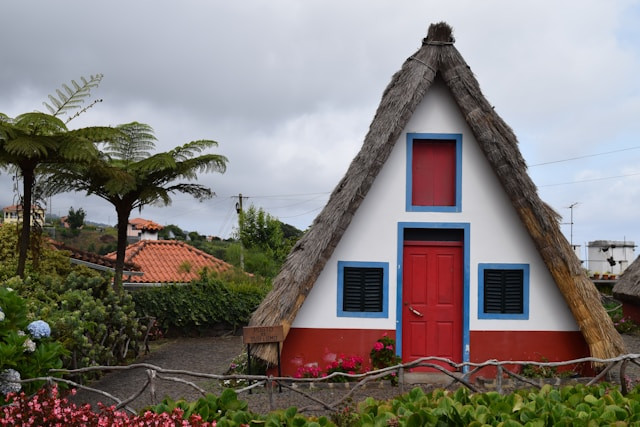
Are you curious to find out more about Portugal?
On our website you can explore a range of topics related to Portugal, including:
- Portugal weather
- Portugal education system
- Portugal accommodation
- Portugal renting tips
- Portugal tax
- Portugal things to do
- Portugal best places
- Portugal cost of living
- Portugal advice
- Portugal FAQs
- Portugal visas
- Portugal residency
Other FAQs about Madeira (Ilha da Madeira)
What is the currency in Madeira Portugal?
The currency used in Madeira, Portugal, is the Euro (€).
Is Madeira a poor island?
Madeira is not typically considered a poor island. It has a relatively stable economy, driven largely by tourism, agriculture, and trade. While there are socioeconomic disparities and pockets of poverty as in any region, Madeira generally enjoys a standard of living comparable to other regions of Portugal.
However, it's essential to recognize that economic conditions can vary within different communities on the island.
What should I know about Madeira time and weather?
When considering Madeira time and weather, it's important to note that the Madeira time zone is the Western European Time Zone (WET), which is UTC+0, and observes daylight saving time from the last Sunday in March to the last Sunday in October, when it switches to Western European Summer Time (WEST), UTC+1.
As for weather in Madeira, it generally enjoys a mild and subtropical climate year-round, with warm summers and mild winters. However, the weather can vary depending on the region and altitude, with coastal areas typically experiencing milder temperatures than inland areas.
It's also worth noting that Madeira's mountainous terrain can result in microclimates, leading to varying weather conditions within relatively short distances.
What are the best towns in Madeira for digital nomads?
For digital nomads, some cities and towns in Madeira offer excellent amenities, infrastructure, and a conducive environment for remote work.
Here are a few that are often favored:
- Funchal
- Ponta do Sol
- Machico
- Santa Cruz
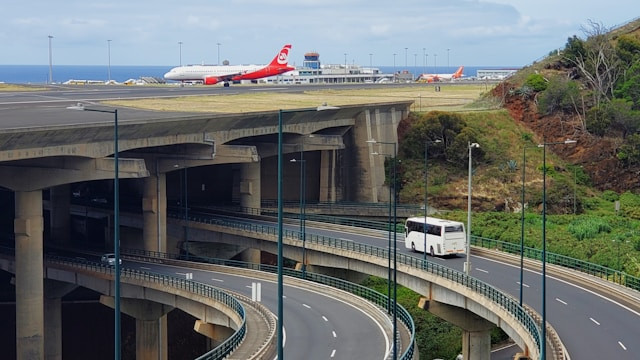
What are the best villages to stay in Madeira?
Some of the best parishes to stay in Madeira include:
- Ponta do Pargo
- Paul do Mar
- Jardim do Mar
- Curral das Freiras
Is Madeira a good place to live?
Madeira can be a fantastic place to live for many people, depending on individual preferences and priorities. Its mild climate, stunning natural beauty, and relatively low cost of living compared to many European cities attract expatriates and retirees seeking a high quality of life.
The island offers a laid-back lifestyle, with opportunities for outdoor activities like hiking, swimming, and enjoying the beautiful landscapes. Additionally, Madeira has modern amenities, good healthcare services, and a stable political environment as part of Portugal.
However, like any location, there may be challenges or drawbacks to consider, such as limited job opportunities in certain industries and potential language barriers for non-Portuguese speakers.
Overall, for those who appreciate a slower pace of life in a picturesque setting, Madeira can be an excellent choice for living.
What is the expat population of Madeira?
The Madeira population was around 250,769 in 2021. The population of expats in Madeira is quite sizable, accounting for about 4.5% of the population.
Flatio: Flexible accommodation in Madeira
If you're looking for flexible, affordable, and deposit-free rentals in Portugal or other regions in Madeira? Check out the listings on Flatio and we believe you’ll find your ideal place.
But why choose Flatio?
Here's a glimpse of the features that distinguish us from other rental accommodation providers:
- Flexible, reasonably priced, remote work-friendly stays (from days to months)
- Wide range of accommodation options (rooms, apartments, houses, etc.)
- Utilities and Wi-Fi included
- Visa-friendly lease agreements
- Online signing of lease agreement
- Renting directly from hosts
- No deposit required for stays under 180 days (unless required by local laws)
- Balanced lease agreement, translated into multiple languages
- Very attractive cancelation policy
- StayProtection for Tenants: assistance with emergencies and accidental property damage
- Move-in Guarantee with a 24/7 emergency line
- 100% money protection
- Support team available every day of the week
- No hidden fees
- Secure and simple payment system, including Bitcoin option
